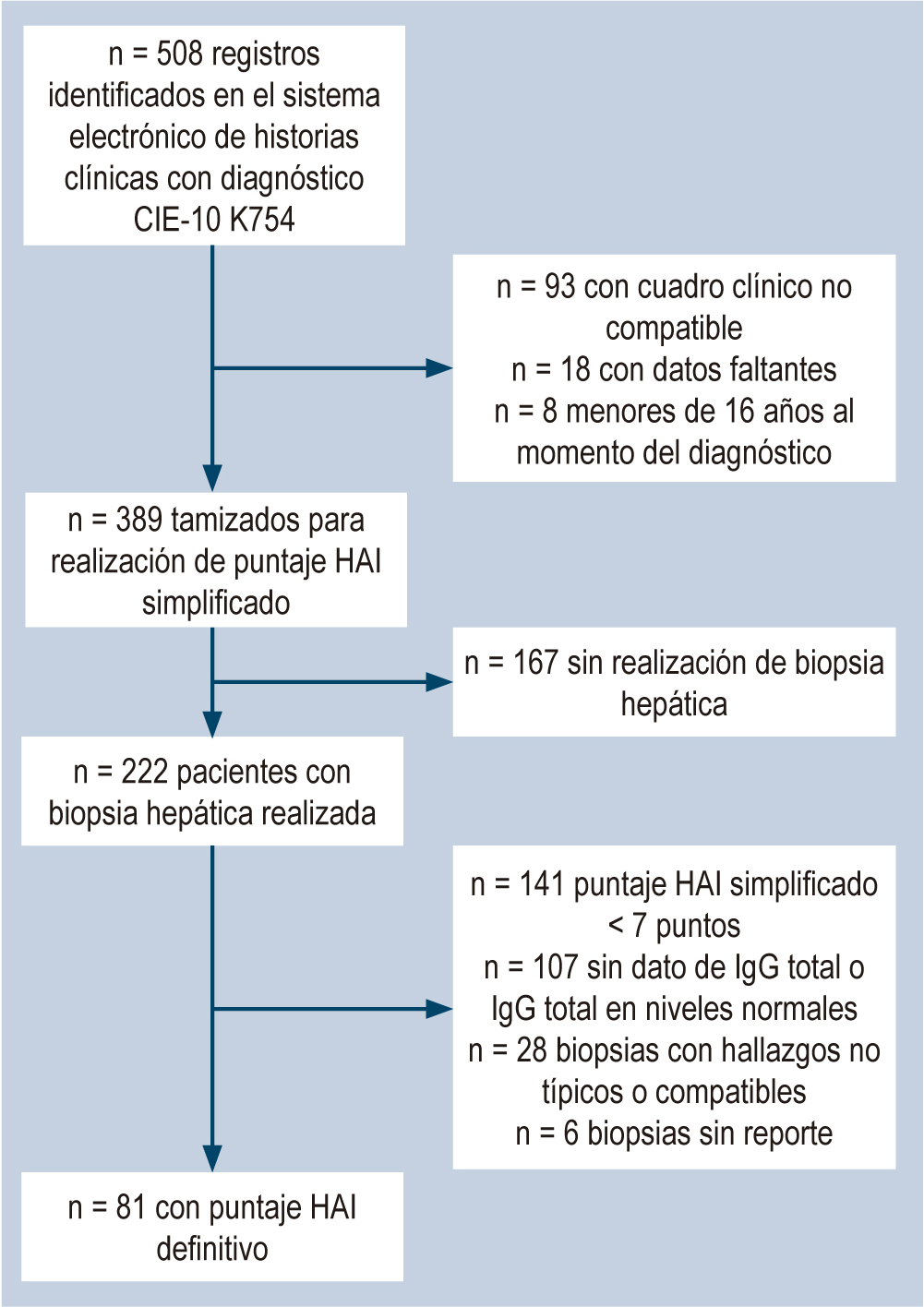Caracterización de pacientes con diagnóstico de hepatitis autoinmune en un hospital de cuarto nivel de Cali, 2014-2020
DOI:
https://doi.org/10.22516/25007440.907Palabras clave:
hepatitis, autoinmune, caliResumen
Introducción: La hepatitis autoinmune (HAI) es una enfermedad inflamatoria crónica del hígado. Es una entidad que no se puede considerar infrecuente, por la falta de datos epidemiológicos, es poco reconocida y tiene implicaciones en el riesgo y aparición de enfermedad hepática avanzada; así mismo, es poco reconocida por los clínicos, y muchas veces se detecta en estadios avanzados. El objetivo de éste estudio es describir las características sociodemográficas, clínicas y de laboratorio, así como, los tratamientos recibidos y la respuesta a éstos, y los desenlaces de interés de los pacientes adultos con diagnóstico de hepatitis autoinmune atendidos en un hospital universitario de la ciudad de Cali, Colombia.
Materiales y métodos: Estudio observacional de cohorte histórica, incluyó pacientes mayores de 18 años de ambos sexos con diagnóstico de HAI atendidos en los servicios de urgencias, consulta externa, cuidado intensivo y hospitalización del Hospital Universitario Fundación Valle del Lili entre enero del 2014 y diciembre del 2019.
Resultados: Un total de 389 pacientes cumplieron los criterios de inclusión (fig.1). El 86% de los pacientes eran mujeres, la mediana de edad era de 50 años (RIC 36-60). Sobre el tratamiento farmacológico, prednisolona y azatioprina fueron los medicamentos más frecuentemente utilizados para el tratamiento de inducción y de mantenimiento. El esquema de prednisolona o prednisolona con azatioprina se aplicó en el 77%, otro tipo de tratamientos iniciales se dieron en 27 pacientes.
Conclusión: La hepatitis autoinmune es una patología cada vez más buscada, cuyo pronóstico está relacionado con la detección, estadificación y tratamiento tempranos. Las dificultades en el diagnóstico histológico en países de bajos recursos pone de manifiesto el requerimiento de buscar alternativas no invasivas y disponibles para detección de fibrosis.
Descargas
Referencias bibliográficas
Strassburg CP, Manns MP. Therapy of autoimmune hepatitis. Best Pract Res Clin Gastroenterol. 2011;25(6):673-87. https://doi.org/10.1016/j.bpg.2011.08.003
Puustinen L, Barner-Rasmussen N, Pukkala E, Färkkilä M. Incidence, prevalence, and causes of death of patients with autoimmune hepatitis: A nationwide register-based cohort study in Finland. Dig Liver Dis. 2019;51(9):1294-1299. https://doi.org/10.1016/j.dld.2019.01.015
Lv T, Li M, Zeng N, Zhang J, Li S, Chen S, et al. Systematic review and meta-analysis on the incidence and prevalence of autoimmune hepatitis in Asian, European, and American population. J Gastroenterol Hepatol. 2019;34(10):1676-1684. https://doi.org/10.1111/jgh.14746
Hennes EM, Zeniya M, Czaja AJ, Parés A, Dalekos GN, Krawitt EL, et al. Simplified criteria for the diagnosis of autoimmune hepatitis. Hepatology. 2008;48(1):169-176. https://doi.org/10.1002/hep.22322
Czaja AJ, Donaldson PT. Gender effects and synergisms with histocompatibility leukocyte antigens in type 1 autoimmune hepatitis. Am J Gastroenterol. 2002;97(8):2051-2057. https://doi.org/10.1111/j.1572-0241.2002.05921.x
O’Grady JG, Schalm SW, Williams R. Acute liver failure: redefining the syndromes. Lancet. 1993;342(8866):273-5. https://doi.org/10.1016/0140-6736(93)91818-7
Grønbæk L, Vilstrup H, Jepsen P. Autoimmune hepatitis in Denmark: incidence, prevalence, prognosis, and causes of death. A nationwide registry-based cohort study. J Hepatol. 2014;60(3):612-617. https://doi.org/10.1016/j.jhep.2013.10.020
Sharma R, Verna EC, Söderling J, Roelstraete B, Hagström H, Ludvigsson JF. Increased Mortality Risk in Autoimmune Hepatitis: A Nationwide Population-Based Cohort Study With Histopathology. Clin Gastroenterol Hepatol. 2021;19(12):2636-2647.e13. https://doi.org/10.1016/j.cgh.2020.10.006
Díaz-Ramírez GS, Marín-Zuluaga JI, Donado-Gómez JH, Muñoz-Maya O, Santos-Sánchez Ó, Restrepo-Gutiérrez JC. Caracterización de los pacientes con hepatitis autoinmune de un hospital universitario, Medellín-Colombia: estudio de cohorte. Gastroenterol Hepatol. 2018;41(2):87-96. https://doi.org/10.1016/j.gastrohep.2017.09.003
Estrada C. Caracterización clínica de pacientes con hepatitis autoinmune atendidos en una institución de salud de la región caribe colombiana. Barranquilla: Universidad Libre; 2019.
Karakaya F, Oztekin S, Ozturk Y, Kalkan C, Melekoglu Ellik Z, Elhan AH, et al. Clinical significance of concomitant extrahepatic autoimmune disease in patients with autoimmune liver disease. Hepatology Forum. 2021;2(1):3-6. https://doi.org/10.14744/hf.2020.2020.0028
Wong GW, Heneghan MA. Association of Extrahepatic Manifestations with Autoimmune Hepatitis. Dig Dis. 2015;33 Suppl 2:25-35. https://doi.org/10.1159/000440707
Efe C, Wahlin S, Ozaslan E, Berlot AH, Purnak T, Muratori L, et al. Autoimmune hepatitis/primary biliary cirrhosis overlap syndrome and associated extrahepatic autoimmune diseases. Eur J Gastroenterol Hepatol. 2012;24(5):531-534. https://doi.org/10.1097/MEG.0b013e328350f95b
Czaja AJ. Diagnosis and Management of Autoimmune Hepatitis: Current Status and Future Directions. Gut Liver. 2016;10(2):177-203. https://doi.org/10.5009/gnl15352
Feld JJ, Dinh H, Arenovich T, Marcus VA, Wanless IR, Heathcote EJ. Autoimmune hepatitis: effect of symptoms and cirrhosis on natural history and outcome. Hepatology. 2005;42(1):53-62. https://doi.org/10.1002/hep.20732
Fujita K, Oura K, Tadokoro T, Nakahara M, Tani J, Morishita A, et al. Prognosis of probable autoimmune hepatitis patients: a single-center study in Japan. Intern Emerg Med. 2021;16(8):2155-2162. https://doi.org/10.1007/s11739-021-02720-0
Liberal R, Grant CR. Cirrhosis and autoimmune liver disease: Current understanding. World J Hepatol. 2016;8(28):1157-1168. https://doi.org/10.4254/wjh.v8.i28.1157
Tiniakos DG, Brain JG, Bury YA. Role of Histopathology in Autoimmune Hepatitis. Dig Dis. 2015;33 Suppl 2:53-64. https://doi.org/10.1159/000440747
Mack CL, Adams D, Assis DN, Kerkar N, Manns MP, Mayo MJ, et al. Diagnosis and Management of Autoimmune Hepatitis in Adults and Children: 2019 Practice Guidance and Guidelines From the American Association for the Study of Liver Diseases. Hepatology. 2020;72(2):671-722. https://doi.org/10.1002/hep.31065
European Association for the Study of the Liver. EASL Clinical Practice Guidelines: Autoimmune hepatitis. J Hepatol. 2015;63(4):971-1004. https://doi.org/10.1016/j.jhep.2015.06.030
van den Brand FF, van der Veen KS, de Boer YS, van Gerven NM, Lissenberg-Witte BI, Beuers U, et al. Increased Mortality Among Patients With vs Without Cirrhosis and Autoimmune Hepatitis. Clin Gastroenterol Hepatol. 2019;17(5):940-947.e2. https://doi.org/10.1016/j.cgh.2018.09.046
To U, Silveira M. Overlap Syndrome of Autoimmune Hepatitis and Primary Biliary Cholangitis. Clin Liver Dis. 2018;22(3):603-611. https://doi.org/10.1016/j.cld.2018.03.010
Chazouillères O, Wendum D, Serfaty L, Montembault S, Rosmorduc O, Poupon R. Primary biliary cirrhosis-autoimmune hepatitis overlap syndrome: clinical features and response to therapy. Hepatology. 1998;28(2):296-301. https://doi.org/10.1002/hep.510280203
Manns MP, Lohse AW, Vergani D. Autoimmune hepatitis--Update 2015. J Hepatol. 2015;62(1 Suppl):S100-S111. https://doi.org/10.1016/j.jhep.2015.03.005
Lamers MM, van Oijen MG, Pronk M, Drenth JP. Treatment options for autoimmune hepatitis: a systematic review of randomized controlled trials. J Hepatol. 2010;53(1):191-198. https://doi.org/10.1016/j.jhep.2010.01.037
Tan P, Marotta P, Ghent C, Adams P. Early treatment response predicts the need for liver transplantation in autoimmune hepatitis. Liver Int. 2005;25(4):728-733. https://doi.org/10.1111/j.1478-3231.2005.01121.x
Sandusadee N, Sukeepaisarnjaroen W, Suttichaimongkol T. Prognostic factors for remission, relapse, and treatment complications in type 1 autoimmune hepatitis. Heliyon. 2020;6(4):e03767. https://doi.org/10.1016/j.heliyon.2020.e03767
Czaja AJ. Late relapse of type 1 autoimmune hepatitis after corticosteroid withdrawal. Dig Dis Sci. 2010;55(6):1761-1769. https://doi.org/10.1007/s10620-010-1243-0
Srivastava S, Boyer JL. Psychological stress is associated with relapse in type 1 autoimmune hepatitis. Liver Int. 2010;30(10):1439-1447. https://doi.org/10.1111/j.1478-3231.2010.02333.x
van Gerven NM, Verwer BJ, Witte BI, van Hoek B, Coenraad MJ, van Erpecum KJ, et al. Relapse is almost universal after withdrawal of immunosuppressive medication in patients with autoimmune hepatitis in remission. J Hepatol. 2013;58(1):141-147. https://doi.org/10.1016/j.jhep.2012.09.009
Montano-Loza AJ, Carpenter HA, Czaja AJ. Consequences of treatment withdrawal in type 1 autoimmune hepatitis. Liver Int. 2007;27(4):507-515. https://doi.org/10.1111/j.1478-3231.2007.01444.x
Danielsson Borssén Å, Marschall HU, Bergquist A, Bergquist A, Rorsman F, Weiland O, et al. Epidemiology and causes of death in a Swedish cohort of patients with autoimmune hepatitis. Scand J Gastroenterol. 2017;52(9):1022-1028. https://doi.org/10.1080/00365521.2017.1335772
Czaja AJ, Rakela J, Ludwig J. Features reflective of early prognosis in corticosteroid-treated severe autoimmune chronic active hepatitis. Gastroenterology. 1988;95(2):448-453. https://doi.org/10.1016/0016-5085(88)90503-3
Muratori P, Lalanne C, Bianchi G, Lenzi M, Muratori L. Predictive factors of poor response to therapy in Autoimmune Hepatitis. Dig Liver Dis. 2016;48(9):1078-1081. https://doi.org/10.1016/j.dld.2016.06.018
Kirstein MM, Metzler F, Geiger E, Heinrich E, Hallensleben M, Manns MP, et al. Prediction of short- and long-term outcome in patients with autoimmune hepatitis. Hepatology. 2015;62(5):1524-1535. https://doi.org/10.1002/hep.27983
Yoshizawa K, Matsumoto A, Ichijo T, Umemura T, Joshita S, Komatsu M, et al. Long-term outcome of Japanese patients with type 1 autoimmune hepatitis. Hepatology. 2012;56(2):668-676. https://doi.org/10.1002/hep.25658
Gleeson D. Long-Term Outcomes of Autoimmune Hepatitis. Clin Liver Dis (Hoboken). 2019;14(1):24-28. https://doi.org/10.1002/cld.797
European Association for the Study of the Liver. Electronic address: easloffice@easloffice.eu; Clinical Practice Guideline Panel; Chair:; EASL Governing Board representative:; Panel members:. EASL Clinical Practice Guidelines on non-invasive tests for evaluation of liver disease severity and prognosis - 2021 update. J Hepatol. 2021;75(3):659-689. https://doi.org/10.1016/j.jhep.2021.05.025
Yuan X, Duan SZ, Cao J, Gao N, Xu J, Zhang L. Noninvasive inflammatory markers for assessing liver fibrosis stage in autoimmune hepatitis patients. Eur J Gastroenterol Hepatol. 2019;31(11):1467-1474. https://doi.org/10.1097/MEG.0000000000001437
Sherigar JM, Yavgeniy A, Guss D, Ngo N, Mohanty S. Seronegative Autoimmune Hepatitis A Clinically Challenging Difficult Diagnosis. Case Rep Med. 2017;2017:3516234. https://doi.org/10.1155/2017/3516234

Descargas
Publicado
Cómo citar
Número
Sección
Licencia

Esta obra está bajo una licencia internacional Creative Commons Atribución-NoComercial-SinDerivadas 4.0.
Aquellos autores/as que tengan publicaciones con esta revista, aceptan los términos siguientes:
Los autores/as ceden sus derechos de autor y garantizarán a la revista el derecho de primera publicación de su obra, el cuál estará simultáneamente sujeto a la Licencia de reconocimiento de Creative Commons que permite a terceros compartir la obra siempre que se indique su autor y su primera publicación en esta revista.
Los contenidos están protegidos bajo una licencia de Creative Commons Reconocimiento-NoComercial-SinObraDerivada 4.0 Internacional.


















